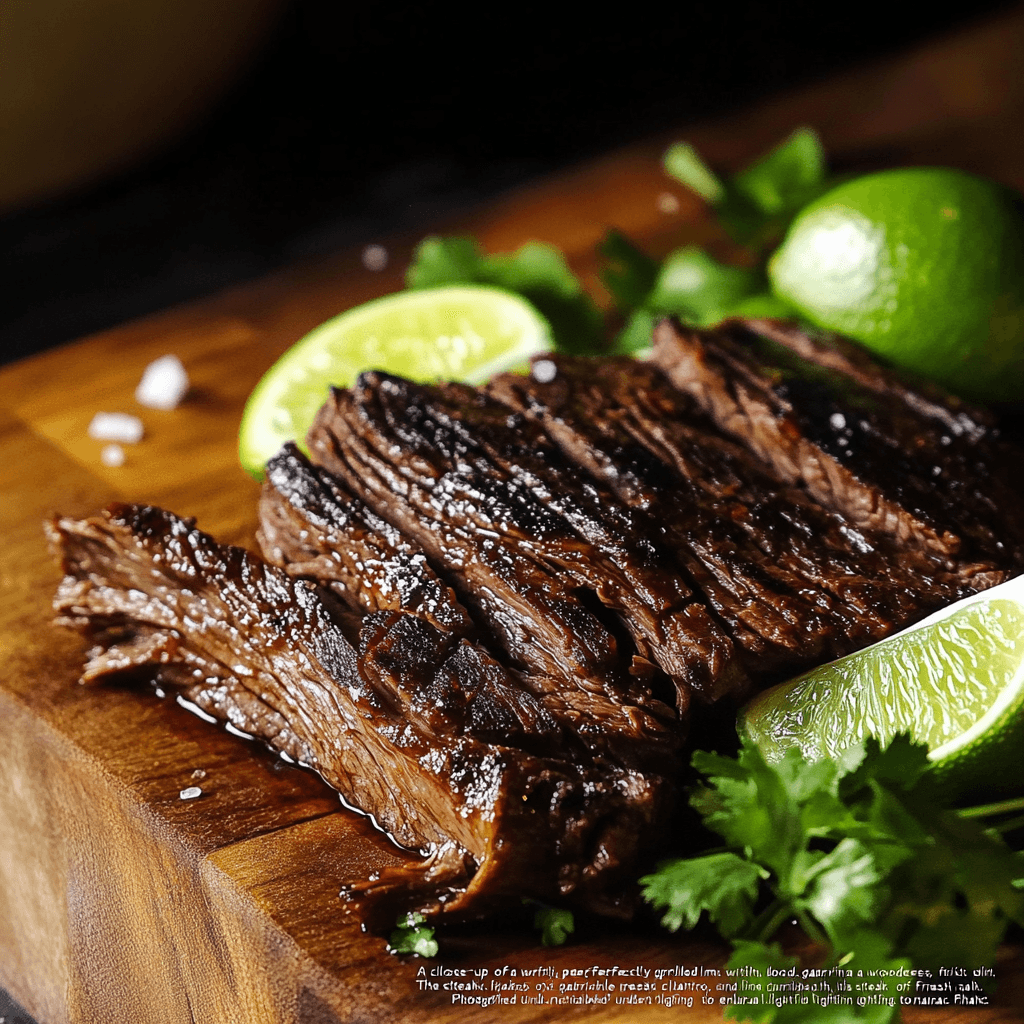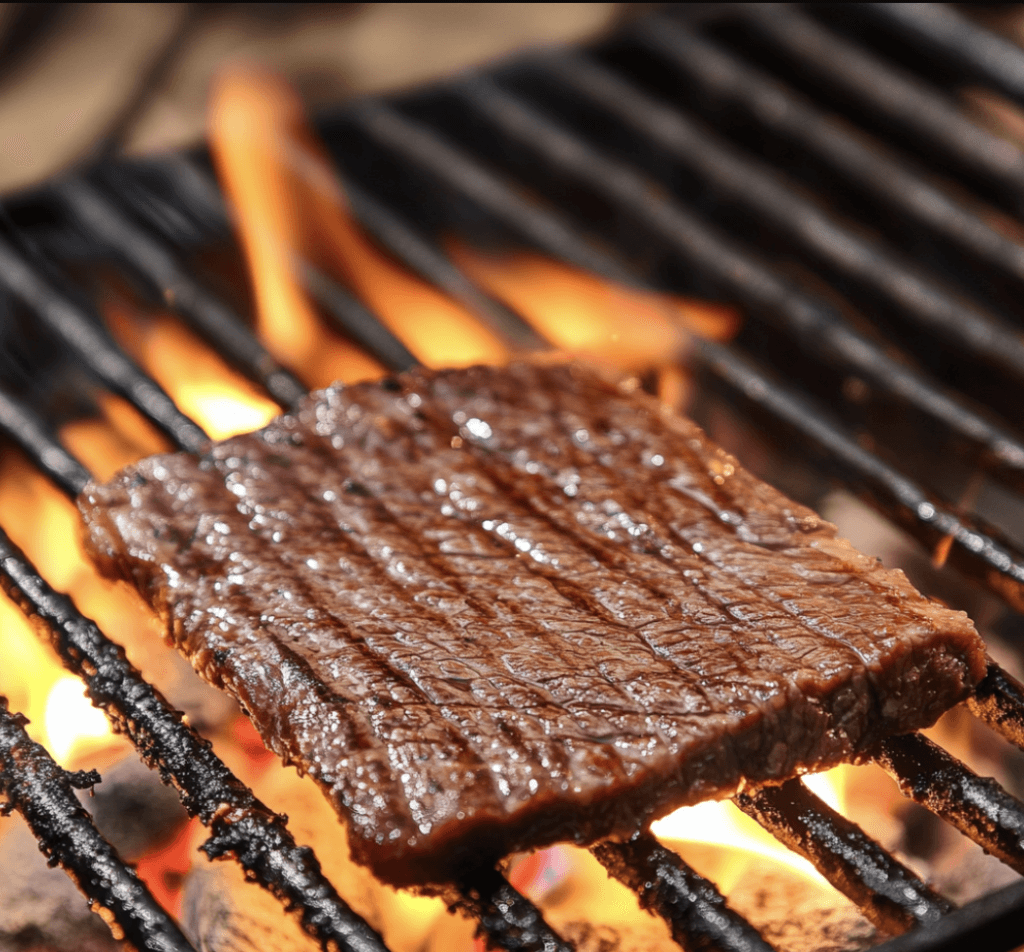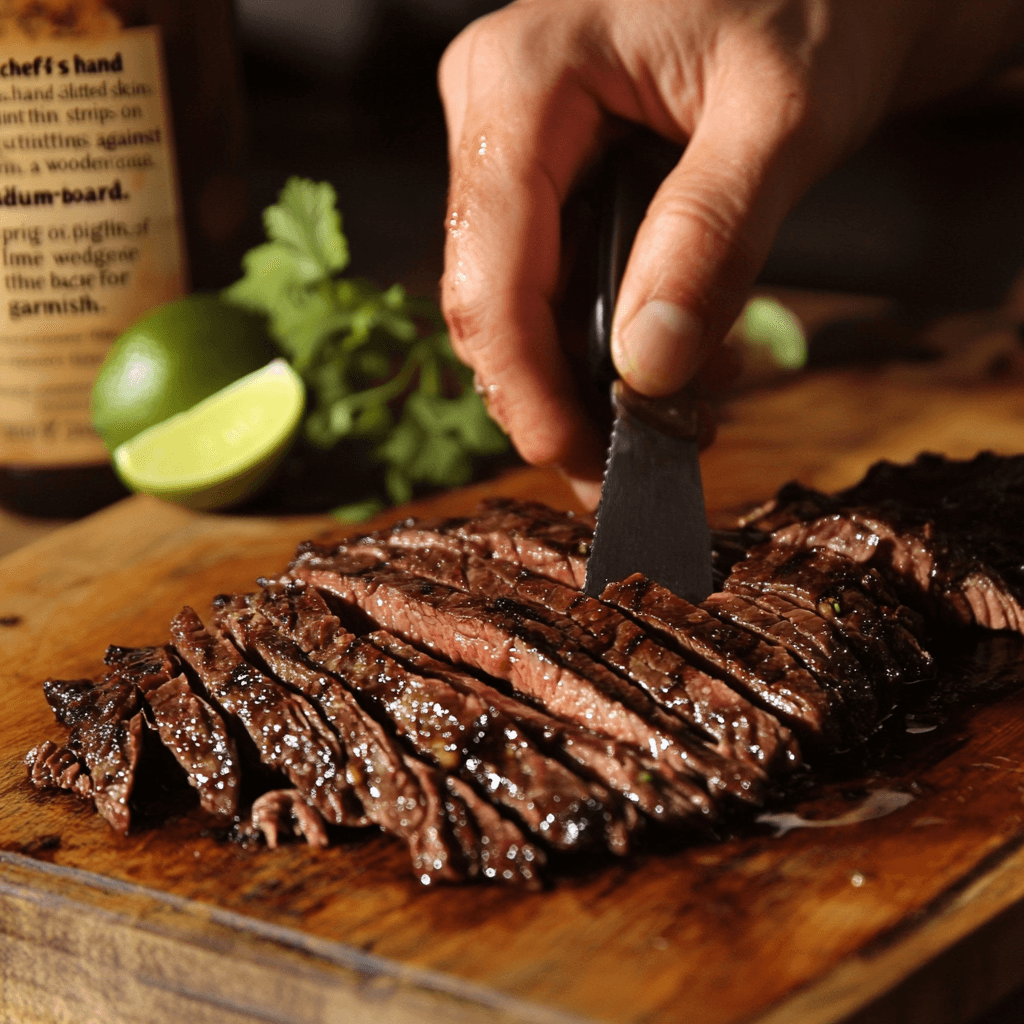Introduction to Skirt Steak
What Makes Skirt Steak Unique?
Skirt steak is a flavorful and versatile cut of beef known for its rich taste and unique texture. It comes from the diaphragm muscle of the cow, located in the plate section near the ribs. This cut is long, flat, and has a coarse grain, making it ideal for quick cooking methods like grilling, searing, or stir-frying. Its pronounced beefy flavor and ability to absorb marinades effectively make it a favorite among culinary enthusiasts and professional chefs alike.
Skirt steak is often used in popular dishes such as fajitas, stir-fries, and carne asada. While it can be slightly tougher compared to other cuts, proper preparation—such as marinating and slicing against the grain—can make it tender and delectable. It’s a relatively affordable cut, celebrated for its versatility and ability to elevate a variety of cuisines.

Table of Contents
History and Origins of Skirt Steak
The origins of skirt steak trace back to its use in traditional Latin American and Mexican cuisines, where it has been a staple ingredient for generations. Historically, it was considered a butcher’s cut, often reserved for personal use due to its intense flavor and less mainstream appeal. This cut gained popularity in home cooking and restaurants when dishes like fajitas and carne asada started gaining recognition globally.
The name “skirt steak” is believed to derive from the cut’s position on the cow, resembling a “skirt” or apron hanging from the lower ribs. Over time, it became widely appreciated not only in Mexican cooking but also in various cuisines worldwide, particularly for its compatibility with bold marinades and spices.
The rise of skirt steak’s popularity in the United States can be linked to the Tex-Mex cuisine boom in the mid-20th century. Its association with casual dining and grilling traditions has cemented its status as a sought-after cut, particularly for those who value flavor over tenderness. Today, it is celebrated as a key ingredient in everything from street food to high-end culinary creations, embodying both its humble roots and its ability to shine in diverse preparations.
Preparing Skirt Steak for Cooking
Choosing the Best Cut for Your Recipe
When preparing skirt steak, choosing the right cut is essential to achieving the best results. Skirt steak comes in two types: inside skirt steak and outside skirt steak. The outside skirt is generally preferred because it is slightly thicker, more uniform in shape, and has better marbling, which contributes to flavor and tenderness. However, the inside skirt is still a good option if properly prepared.
When selecting skirt steak, look for cuts with a deep red color and a consistent thickness. Avoid steaks with excessive fat or gristle, as these can make trimming more challenging. If possible, purchase from a reputable butcher or store that offers high-quality beef to ensure the freshest cut.
Trimming Tips for Tender Meat
Proper trimming is a crucial step in preparing skirt steak to ensure a pleasant eating experience. Skirt steak often comes with a silver skin (a thin, tough membrane) and some excess fat that need to be removed before cooking. Follow these steps for trimming:
- Lay the Steak Flat: Place the skirt steak on a cutting board, ensuring the surface is clean and stable.
- Remove the Silver Skin: Use a sharp knife to carefully slice under the silver skin at one edge, pulling it taut while working the knife along the length of the steak to separate it.
- Trim Excess Fat: Skirt steak has pockets of fat that do not render during cooking. Trim these carefully without removing too much of the meat.
- Portion if Necessary: If the steak is too long for your pan or grill, cut it into smaller, manageable portions.
Trimming helps the steak cook evenly and improves the texture of the final dish.
The Importance of Marinating Skirt Steak
Marinating is one of the most important steps when preparing skirt steak, as it enhances flavor and helps tenderize the meat. Skirt steak’s coarse texture and open grain make it highly receptive to marinades, allowing the flavors to penetrate deeply.
Why Marinate?
- Flavor Infusion: Marinades made with ingredients like citrus, vinegar, soy sauce, or garlic add bold, complementary flavors to the beef.
- Tenderization: Acidic components, such as lime juice or wine, help break down connective tissues, improving the steak’s tenderness.
- Juiciness: Marinades with oils and spices help retain moisture during cooking, preventing the steak from drying out.
Tips for Marinating Skirt Steak:
- Use a sealable plastic bag or a non-reactive container (like glass or stainless steel) to hold the steak and marinade.
- Let the steak marinate for at least 30 minutes, but ideally 4-6 hours for maximum flavor. Avoid over-marinating, as the acid can make the meat mushy.
- Pat the steak dry before cooking to ensure a proper sear and prevent steaming.
Different Cooking Methods for Skirt Steak
Step-by-Step Guide to Grilling Perfection

Grilling is one of the best ways to cook skirt steak, as it allows the high heat to quickly sear the meat, enhancing its natural flavors and creating a beautifully charred exterior. Here’s a step-by-step guide to grilling skirt steak:
- Preheat the Grill: Heat your grill to high (450-500°F) to ensure a quick sear and prevent overcooking.
- Prepare the Steak: Pat the marinated or seasoned skirt steak dry with paper towels to promote a good sear. Lightly brush with oil to prevent sticking.
- Grill the Steak: Place the steak on the grill grates. Cook for about 2-3 minutes per side for medium-rare, or longer if you prefer more doneness.
- Check the Temperature: Use an instant-read thermometer to ensure the steak reaches your desired level of doneness (125-130°F for medium-rare).
- Rest and Slice: Let the steak rest for 5-10 minutes to allow the juices to redistribute. Slice against the grain into thin strips to maximize tenderness.
Grilling is ideal for outdoor gatherings and adds a smoky flavor to the steak that complements its rich taste.
Pan-Searing Skirt Steak: Tips for Perfectly Cooked Meat
Pan-searing is a quick and convenient method for cooking skirt steak, especially when you don’t have access to a grill. Follow these tips for achieving perfectly cooked steak:
- Choose the Right Pan: Use a heavy-bottomed pan, such as a cast-iron skillet, which retains and distributes heat evenly.
- Heat the Pan: Preheat the skillet over high heat until it’s very hot. Add a high-smoke-point oil, such as avocado or canola oil, to coat the pan lightly.
- Sear the Steak: Place the steak in the pan and cook for 2-4 minutes on each side, depending on the thickness, to achieve a golden-brown crust.
- Avoid Overcrowding: Cook the steak in batches if necessary to ensure proper searing. Overcrowding the pan can cause the steak to steam rather than sear.
- Baste for Extra Flavor: For added richness, toss in a knob of butter, garlic, and fresh herbs (such as rosemary or thyme) during the last minute of cooking and spoon the melted butter over the steak.
- Check the Temperature: Use an instant-read thermometer to ensure the steak is cooked to your preference.
Pan-searing creates a delicious crust and is ideal for quick, flavorful meals.
Broiling Skirt Steak: What You Need to Know
Broiling is a great method for cooking skirt steak indoors, providing high, direct heat similar to grilling. Here’s what you need to know:
- Preheat the Broiler: Set your oven to the broil setting and allow it to preheat for about 10 minutes. Place the oven rack about 4-6 inches below the broiler element.
- Prepare the Steak: Line a baking sheet with foil and place the steak on it. Lightly oil the steak and season as desired.
- Broil the Steak: Place the baking sheet under the broiler. Cook for 2-4 minutes per side, flipping halfway through. Keep a close eye on the steak to avoid burning.
- Monitor Doneness: Use an instant-read thermometer to check the internal temperature. Aim for 125-130°F for medium-rare.
- Rest and Slice: Allow the steak to rest for a few minutes after broiling, then slice thinly against the grain.
Key Factors for Perfectly Cooked Skirt Steak
Understanding the Right Temperature for Skirt Steak
Temperature is critical when cooking skirt steak, as this cut is thin and cooks quickly. Overcooking can result in a tough, chewy texture, while undercooking may not develop the flavors fully. Use a meat thermometer to achieve precise results:
- Rare: 120-125°F (cool red center)
- Medium-Rare: 125-130°F (warm red center)
- Medium: 135-145°F (pink center)
- Medium-Well: 145-155°F (slightly pink center)
- Well-Done: 160°F and above (no pink, firm throughout)
For the best flavor and tenderness, medium-rare (125-130°F) is the most recommended doneness for skirt steak.
How to Achieve the Desired Level of Doneness (Rare, Medium, Well-Done)
To achieve the desired level of doneness, timing and technique are essential:
- High Heat Cooking: Skirt steak is best cooked over high heat, whether grilling, pan-searing, or broiling. This ensures a nice sear on the outside while retaining juiciness inside.
- Monitor Cooking Time:
- Rare: 2 minutes per side
- Medium-Rare: 2-3 minutes per side
- Medium: 3-4 minutes per side
- Medium-Well: 4-5 minutes per side
- Well-Done: 5-6 minutes per side
- Use a Meat Thermometer: Insert the thermometer into the thickest part of the steak to check the temperature without cutting into the meat.
- Adjust for Thickness: If your steak is thicker or thinner than average, adjust cooking time accordingly. Thin cuts will cook faster and may require extra attention.
- Finish with Carryover Heat: Remove the steak from heat just before it reaches your desired temperature, as the internal heat will continue cooking the steak slightly during resting.
Resting Time After Cooking Skirt Steak
Resting is a crucial but often overlooked step in cooking skirt steak. Once removed from the heat, the steak’s juices redistribute throughout the meat, ensuring maximum flavor and tenderness.
Key Tips for Resting:
- Duration: Allow the steak to rest for 5-10 minutes, depending on its size.
- Cover Loosely: Place the steak on a cutting board and tent it loosely with aluminum foil to retain warmth without steaming.
- Slice Properly: Always slice the steak against the grain into thin strips. This shortens the muscle fibers, making the steak easier to chew and more tender.
Frequently Asked Questions (FAQs)
What is the best way to cook skirt steak for a tender result?
The best way to cook skirt steak for tenderness is to use high heat and cook it quickly, such as grilling, pan-searing, or broiling. Marinating the steak beforehand helps tenderize it and enhances flavor. Additionally, slicing the cooked steak against the grain into thin strips shortens the muscle fibers, making the steak easier to chew and more tender.
How long should skirt steak be marinated?
Skirt steak should be marinated for at least 30 minutes, but for optimal flavor and tenderness, marinate it for 4-6 hours. Avoid marinating for longer than 12 hours, as the acidic components in the marinade can break down the meat fibers too much, resulting in a mushy texture.
Can skirt steak be cooked well done?
Yes, skirt steak can be cooked well done, but it’s not recommended, as it can become tough and dry. If you prefer well-done meat, ensure you use a marinade to retain moisture and cook the steak over high heat to sear it quickly, avoiding overcooking. For better results, medium-rare to medium doneness is ideal for skirt steak.
What is the best side dish to serve with skirt steak?
Skirt steak pairs well with a variety of side dishes, especially those that complement its bold flavor. Some popular options include:
- Grilled Vegetables: Zucchini, bell peppers, or asparagus.
- Potatoes: Mashed, roasted, or fries.
- Rice Dishes: Mexican rice, cilantro lime rice, or pilaf.
- Salads: A fresh green salad or coleslaw.
- Corn Dishes: Grilled corn on the cob or corn salsa. For a complete meal, combine a starchy side with a fresh or tangy accompaniment.
How do you know when skirt steak is done?
The best way to know when skirt steak is done is by using an instant-read thermometer to check the internal temperature:
- Rare: 120-125°F
- Medium-Rare: 125-130°F
- Medium: 135-145°F
- Medium-Well: 145-155°F
- Well-Done: 160°F and above
For those without a thermometer, you can use the finger test for doneness or visually check the meat’s interior color after cutting a small piece.
Can skirt steak be cooked on the stove?
Yes, skirt steak can be cooked on the stove using a pan-searing method. A cast-iron skillet is ideal for this as it retains heat well and creates a beautiful sear. Heat the pan over high heat, add a little oil, and cook the steak for 2-4 minutes per side, depending on your desired doneness. This method is quick and delivers excellent results without needing a grill.
Conclusion
Recap of Skirt Steak Cooking Tips and Techniques

Skirt steak is a flavorful and versatile cut of beef that can be transformed into a delicious meal with the right preparation and cooking techniques. Here’s a quick recap of key tips to ensure your skirt steak is perfectly cooked every time:
- Selecting and Preparing the Steak: Choose a high-quality cut, preferably outside skirt steak for better marbling and uniformity. Trim any silver skin and excess fat for a better texture and appearance.
- Marinating: Marinate the steak for at least 30 minutes, or up to 6 hours, to enhance flavor and tenderize the meat. Use marinades with acidic and flavorful ingredients like citrus, vinegar, or soy sauce.
- Cooking Methods: Use high-heat cooking methods like grilling, pan-searing, or broiling for a quick sear and maximum flavor.
- Grill: Cook over high heat for a smoky, charred exterior.
- Pan-Sear: Use a hot skillet for a golden-brown crust.
- Broil: Ideal for indoor cooking, providing similar results to grilling.
- Achieving the Right Doneness: Use an instant-read thermometer to ensure the steak reaches the desired internal temperature:
- Rare: 120-125°F
- Medium-Rare: 125-130°F (ideal for tenderness)
- Medium: 135-145°F
- Resting and Slicing: Allow the steak to rest for 5-10 minutes to retain its juices. Always slice against the grain into thin strips to maximize tenderness.
- Serving Suggestions: Pair Beef plate cut with sides like grilled vegetables, rice, potatoes, or fresh salads to create a well-rounded meal.
By following these tips, you’ll be able to unlock the full potential of Beef plate cut, enjoying its rich flavor and texture in every bite. Whether you’re grilling for a gathering or pan-searing for a weeknight dinner, Beef plate cut is sure to impress when prepared with care and attention.
